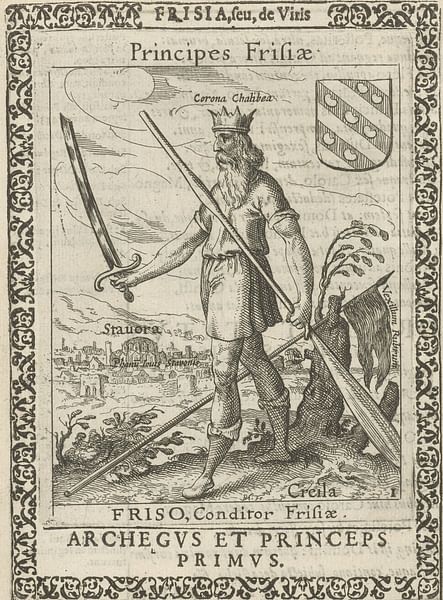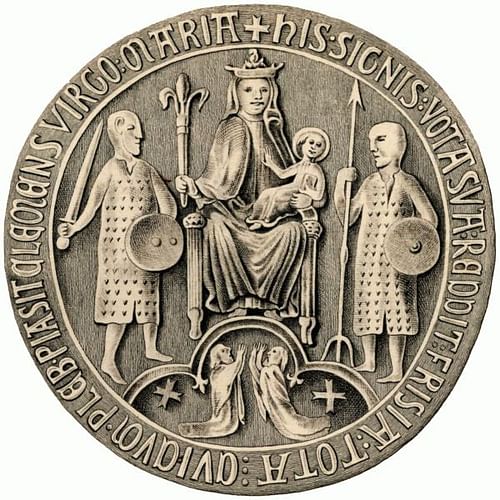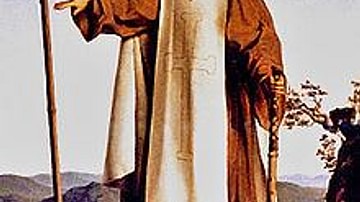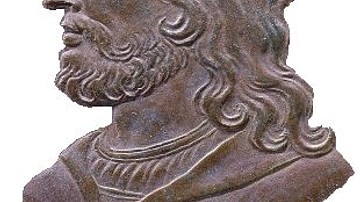
Redbad, the king of Frisians (c. 680- c. 719) was known in early medieval history for his contribution to keeping the ardent nature of the Frisian culture alive. He refused to convert to the new religion and fevered the followers of the pagan ways to revolt. During his reign, the enormous uprisings led to the dominion of the Frisian kingdom.
Frisia in Antiquity
The literary sources first mention Frisian-Roman contact when Rome starts to expand towards the territories north of the Rhine. The local community's first recorded experience with the Mediterranean civilization was their submission to the Roman army in 12 BCE. The roman politician and commander Drusus (38-9 BCE), Claudian patrician, forced them to pay yearly tributes in cowhides, as cattle husbandry was prevalent in the region. In 28 CE, the Frisians, using the Roman Empire's extreme demand for cowhide tributes as an excuse, finally managed to get organized and revolted against Roman rule. The rebellion was crushed.
Although the Roman general Corbulo (7-67 CE), the brother-in-law of the Roman emperor Caligula, led another expedition against the Frisians in 47 CE, Rome instructed the troops not to move north from the Rhine Frontier. The Roman retreat gave the pretext for the locals to get more organized, and in 69-70 CE, the Frisians, the Batavians, who lived around the Rhine Frontier, the Cananefaten, who lived south of the Frisian territory, and the Chauci from the eastern front of the region rose in the Batavian Revolt. The rebellion was eventually crushed, and the interactions between Frisians and Romans continued through trading and mercenary relations.
During the late 2nd century CE, the Roman presence ceased after the mass flooding of the region above the Rhine Frontier, as the water levels rose above the land's surface. Information on the Frisians emerged again in the 6th century when the locals in the wider areas of the region are recorded to have had trade relations and cultural interaction with the communities of Scandinavia as well as with the Anglo-Saxons. Contact with the coastal areas of Scandinavia is reflected in the saga of Beowulf, where the first known Frisian king is mentioned. Finn ascended the throne before c. 523 and was described as the king of the region on the estuary of the Rhine.
During this period, the Frisians also started to interact with the Franks due to claims on the regions above the Rhine. Strong Frisian pagan culture is attested by the abandonment of the missions of Christian Frankish representatives.

Greater Frisia & the Rise of Redbad
The early 7th century represented the period of Greater Frisia, Frisian domination in the region. King Aldgisl converted to Christianity and introduced the new religion into his kingdom. His interactions with Christianity may have begun in 678, when Archbishop Wilfried (c. 633-709/10), fleeing from York, sought protection in Utrecht from the Franks, laying the foundation for future economic and cultural relations with York. Thus, a variety of Anglo-Saxon missionaries arrived in the region, converting the local communities. Aldgisl was reported to control Dorestad in 678, an important trade center that can be traced a few kilometers east of the modern city of Utrecht.
In 680 CE, Redbad succeeded to the throne and inherited a vast kingdom that stretched from northern Flanders to the Weser valley in modern Germany. He was a different ruler than his predecessor and played an important role in returning to the old pagan Frisian way of life. Before 690, the Franks under Pepin II (c. 635-714) conquered the southern part of Frisia, including Dorestad. The adverse mentality of Redbad combined with the religious differences between the two cultures put further strain on the relations between the Frisians and the Franks. Nevertheless, avoiding open conflict was in the interests of both sides. A treaty between them recognized the region north of the Rhine as a frontier among the kingdoms. It is worth mentioning that Frankish sources do not refer to Redbad as rex (king), but a dux, which indicated the Frankish need to demonstrate Redbad as a usurper, thus justifying their expansion towards the north.
The newly annexed area provided the base for Franco-Christian operations against the local pagan Frisians. In 695, Saint Willibrord (c. 658-739) was consecrated as the first bishop of Utrecht, and so with the law on the medieval Church's side, they would have been able to systematically convert even more members of the northern communities. While the new administrative order was being established in the Utrecht area, Pepin, who had already constructed his fort in the city, started minting Frankish coins at Dorestad in 696. The production of Frankish coins in Frisia signified the intentions of integrating the foreign society into the Frankish state through the introduction of the new economic system, as well as through the exploitation of the regional resources.

The conversion to Christianity was applauded by Pepin II, who offered special protection to new believers. Even though economic, cultural, and political life was dominated by the Christian elite, the Frisians showed significant resistance to letting their pagan roots behind. To cement Frankish domination, Pepin pursued a marriage between his youngest son Grimoald (d. c. 714 CE) and the daughter of Redbad, Theudesinda, in a gesture of unification.
The Aftermath
In 714, the death of Pepin brought chaos and civil war. Redbad exploited the opportunity and recaptured most of lower Frisia. In 716, he sailed even further and threatened Cologne, but by 717, Charles Martel (c. 688-741) led the Franks against the people of Frisia and emerged victorious against his rivals in the battle for Utrecht in 718. The next year Redbad died, with no clear evidence for the means of his demise. The Frankish leader moved forward north, attaching Kennemerland into his possessions and forcing the Frisians to retreat to the north-western region.
Frisian forces must have been formidable due to Pepin's preparations for the battle from the 690s, and so modern scholars claim that the news of Redbad's death must have brought relief to the Christian sovereign realms, due to the end of the open conflict. However, the death of Redbad, the Frisian king who rallied the believers of the old ways, brought upheaval and unrest in the Frisian territories. The Frisian strive for independence did not end, and most of Frisia (what is now the modern Netherlands) was reconquered by 734.
The struggle for autonomy was reflected in the continuous interactions of missionaries, such as Saint Willibrord and Saint Boniface (c. 675-754), who held raids to convert and appease the dissatisfaction of the locals. The death of Redbad gave Saint Boniface and opportunity to take his missionary activity to the valley above the Rhine. Frisian defiance, however, persisted, and in 754, Saint Boniface was killed by pagans. Only at the end of the 8th century during the reign of Charlemagne of the Carolingian Dynasty (768-814) were the Frisians conquered, and eventually integrated into this broad western realm.
Culture
The communities, which could be considered the earliest Frisians, were formed before the 5th century BCE by the movements of people towards the swampy territories of the northern Netherlands. Most of the populations, who immigrated to Frisia from the southeast regions, were fragments of the larger movements of people from the middle Weser valley. Others, in smaller numbers, arrived at the less dense northern territories from the wider area of modern North and South Holland. A portion of the newly arrived populations settled in the modern province of Drenthe, where they intermingled with the earliest inhabitants of the region, while others moved to the recently emerged northern coastal North Sea areas of modern Friesland and Groningen, where the water levels became lower than in the previous years, thus, providing additional land to aspiring explorers.
The unpredictable nature of the topography made the Frisians magnificently adapt to the unfriendly environment. Even though the landscape has open access to the sea, it comprises a network of tidal creeks and gullies. The ancient communities of the region were a small collective of farms, granaries, and work sheds. Besides the separation from the European hinterlands, the different culture of the locals is attested by the terpen. The Frisian word originally meant village and defines the elevated dwelling mounds of coastal Frisia. They worked as a barricade against the unforeseen and occasionally stormy rising sea level. The elevated area provided for a safe and dry residence, where animal husbandry could take place as well. Furthermore, the hostile environment provided the opportunity for significant growth in trade operations. Until the arrival of Vikings in the 9th century CE, the Frisians dominated northern European commerce. The Frisians had advantages over Scandinavian and English traders since they controlled the Rhine-Maas-Schelde delta. Thus, they had access to the European heartland.









